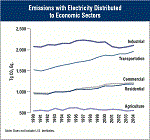First of all, a warm welcome to the viewers from ABC’s Good Morning America and Nightline who are here for the first time. For those who want to know a little more about my project, please noodle around on the blog. For good background, you can start by reading this.
Today’s post, though, is less about my No Impact Man antics and more about how each of us can help. There are a whole bunch of sites that tell you about umpteen thousand measures you can take to help the planet’s various problems—and I am trying to learn to do a lot of them. But I don’t want to overwhelm you. Each of us can only do what we can do. If there is one thing to concentrate on, it’s reversing global warming.
As environmentalist Bill McKibben told me on the phone the other day, “We have to do triage here.” We have to fix the most desperate problems first, he said. It’s a matter of making sure the patient is breathing before you fix the broken arm. Just now, when it comes to getting rid of its carbon dioxide, the planet isn’t breathing well. To read my very, very quick summary of the climate change problem, go here.
Today’s point, meanwhile, is what No Impact Man is all about: how changes in the way we live can help reduce greenhouse gas emissions. And they can. In fact, the recent report from the Intergovernmental Panel on Climate Change that came out on May 4 specifically said: “Changes in lifestyle and behavior patterns can contribute to climate change mitigation.”
That’s not to say there aren’t other areas that we need to work on as a culture. Of the economic sectors, industry makes the largest contribution to greenhouse gas emissions, followed closely by transportation (see the chart from the EPA, above, which you can click to enlarge). To get reductions in these sectors, however, will require a concerted strategic effort by our political representatives—something I will write about tomorrow.
For today, I just want to tell you the biggest things each of us as individuals can do. And not all of us can do all of them, or even any of them. If you can only get to work by car, for example, it may be very hard for you to manage the first suggestion (though you could rideshare).
Drive less: The overwhelming majority of greenhouse gas contributed by the transportation sector comes from cars. As a society, we are exploring a number of options such as biofuels and more fuel-efficient vehicles. But for now—and I’m sorry to be the bearer of bad news—the only way to decrease automobiles’ contribution to climate change is to just plain use them less. Bike, walk, scooter, use public transportation, carpool, take fewer trips. It doesn’t have to be every trip. Even once in a while is good. Cutting out one trip in ten means you’ve slashed your automobile related greenhouse gases by 10 percent. If you reduce your mileage by 20 miles a week you can keep up to 1000 lbs of CO2 out of the air annually.
Fly less: One round-trip, long-haul flight causes as much contribution to climate change as—get this—an entire year of driving. Vacation closer to home. Take direct flights that don’t zigzag to your destination. Combine three weekend trips into one week-long trip. Do business by teleconference and save your company cash. Take the train or bus instead. One less round trip means 6000 lbs less greenhouse gas.
Use less power: After transportation, the largest emission of carbon gas we are responsible for comes from the use of household appliances and heating, cooling, and lighting our homes. Insulate, turn down your water heater, ask your power company about buying “green electricity,” turn your thermostat down a few degrees in winter and up in summer, use EnergyStar appliances, install high-efficiency compact fluorescent lightbulbs, turn everything off and unplug it when your not using it, hang your clothes out to dry, and just plain use less. It doesn’t have to hurt. Every bit can help.
Make good for your damage: At times, of course, you may have to drive or fly more than you’d like to. On those occasions, you can make contributions to projects intended to reduce carbon emissions. It’s called “carbon offsetting.” The idea is that you offset your own unavoidable greenhouse gases by helping someone else to reduce theirs. Offsetting is not a replacement for reducing your energy use. It doesn’t undo your damage, but as second best measure, it may help reduce future damage. Be careful though, the carbon offset market is full of cowboys (see here), but there are some trustworthy sources. I like Native Energy. For a Tufts University assessment of a number of carbon offset programs, look here.
And that’s it! Tune in tomorrow for how you can help reduce industrial and transportation sector emissions.
PS If you’re overcome with enthusiasm, you can join in with a bunch of bloggers who are putting together Low Impact Week, which starts on June 1st.
